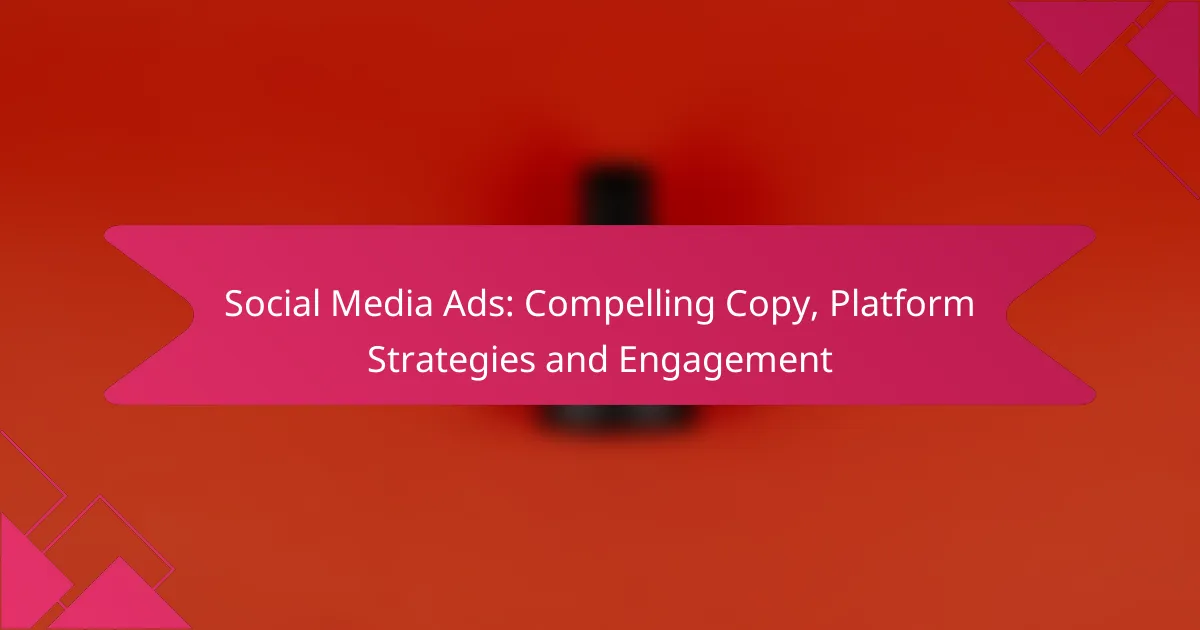User-generated content (UGC) plays a crucial role in enhancing social media ads by offering authentic and relatable material that resonates with audiences. By showcasing real users’ experiences, brands can build trust and foster deeper engagement, ultimately leading to stronger connections with potential customers.

How can user-generated content enhance social media ads?
User-generated content (UGC) can significantly enhance social media ads by providing authentic and relatable material that resonates with audiences. By leveraging content created by real users, brands can foster trust and create a more engaging experience for potential customers.
Increased authenticity
User-generated content boosts authenticity in social media ads, as it showcases real experiences and opinions from actual customers. This genuine representation can help potential buyers feel more connected to the brand, as they see relatable stories and images rather than polished marketing materials.
To maximize authenticity, brands should encourage customers to share their experiences through photos, videos, or testimonials. Highlighting these contributions in ads can create a more trustworthy image and foster a sense of community around the brand.
Higher engagement rates
Social media ads featuring user-generated content often achieve higher engagement rates compared to traditional ads. Audiences are more likely to interact with content that feels personal and relatable, leading to increased likes, shares, and comments.
Brands can enhance engagement by actively inviting customers to participate in campaigns, such as contests or challenges. This not only generates more UGC but also encourages users to engage with the brand, creating a cycle of interaction and visibility.
Cost-effective marketing
Utilizing user-generated content can be a cost-effective marketing strategy, as it reduces the need for expensive professional shoots or content creation. Brands can repurpose existing customer content, saving both time and money while still delivering compelling ads.
To optimize costs, brands should establish clear guidelines for UGC submissions, ensuring that the content aligns with their marketing goals. This approach allows for a steady stream of authentic content without significant investment.
Improved brand loyalty
Incorporating user-generated content into social media ads can lead to improved brand loyalty, as customers feel valued when their contributions are recognized. This sense of belonging can encourage repeat purchases and foster long-term relationships with the brand.
Brands should consider creating a dedicated space for UGC, such as a hashtag or a community page, where customers can showcase their content. Engaging with these users by sharing their posts or featuring them in ads can strengthen the bond between the brand and its audience.

What are the best practices for leveraging user-generated content?
To effectively leverage user-generated content (UGC), brands should focus on authenticity and engagement. This involves actively involving customers in content creation and showcasing their genuine experiences with the brand.
Encourage customer participation
Encouraging customer participation is crucial for generating user-generated content. Brands can create campaigns that invite customers to share their experiences, such as contests or challenges that reward submissions with discounts or features on the brand’s social media channels.
Consider using prompts that inspire creativity, like asking customers to share their favorite ways to use a product. This not only fosters engagement but also builds a community around the brand.
Showcase real customer stories
Showcasing real customer stories enhances authenticity and relatability. Highlighting testimonials or case studies on social media or the brand’s website can demonstrate how products positively impact users’ lives.
Brands should seek permission to share these stories and present them in a visually appealing format, such as videos or infographics, to maximize engagement. This approach helps potential customers see the value of the product through the eyes of their peers.
Utilize hashtags effectively
Using hashtags effectively can amplify the reach of user-generated content. Brands should create unique, memorable hashtags that encourage customers to tag their posts, making it easier to find and share UGC.
In addition to branded hashtags, consider using popular industry-related hashtags to increase visibility. Regularly monitor these tags to engage with customers and showcase their content on the brand’s platforms, reinforcing a sense of community.

How does authenticity impact social media advertising?
Authenticity significantly influences social media advertising by fostering genuine connections between brands and consumers. When users perceive content as authentic, they are more likely to engage with it, leading to increased trust and loyalty.
Builds trust with consumers
Authentic content resonates with consumers, making them feel more connected to a brand. When users see real experiences shared by others, they are more inclined to trust the brand behind the advertisement. This trust is crucial, as consumers often rely on peer recommendations over traditional advertising.
To build trust, brands should encourage user-generated content (UGC) that showcases real customers using their products. This can include testimonials, reviews, or social media posts featuring the product in everyday settings.
Enhances brand reputation
Authenticity helps enhance a brand’s reputation by portraying it as relatable and transparent. Brands that share genuine stories and engage with their audience authentically are often viewed more favorably than those that rely solely on polished marketing tactics.
For example, brands that showcase behind-the-scenes content or highlight their values and mission can create a positive image. This approach not only attracts new customers but also strengthens existing relationships.
Drives conversion rates
Authentic social media advertising can lead to higher conversion rates by encouraging users to take action. When potential customers see relatable content, they are more likely to feel motivated to purchase, as they trust the brand and its offerings.
To maximize conversions, brands should incorporate UGC into their advertising strategies. This can involve featuring customer photos or videos in ads, which can lead to increased engagement and sales. Additionally, providing clear calls-to-action alongside authentic content can further drive conversions.

What platforms are most effective for user-generated content?
Platforms like Instagram, Facebook, and TikTok are particularly effective for user-generated content (UGC) due to their unique features that foster engagement and authenticity. Each platform offers distinct advantages, making them suitable for different types of campaigns and audiences.
Instagram for visual storytelling
Instagram excels in visual storytelling, making it ideal for brands that want to showcase products through high-quality images and videos. User-generated content on this platform often includes aesthetically pleasing photos, which can significantly enhance brand perception.
To leverage Instagram effectively, brands should encourage users to share their experiences with products using specific hashtags. This not only builds community but also creates a library of authentic content that can be reposted to enhance engagement.
Facebook for community engagement
Facebook is a powerful tool for fostering community engagement through user-generated content. Brands can create dedicated groups or pages where users share their experiences, ask questions, and provide feedback, creating a sense of belonging.
To maximize effectiveness on Facebook, brands should actively participate in discussions and encourage users to share their stories. This two-way communication can lead to increased loyalty and trust, as users feel valued and heard.
TikTok for viral content
TikTok is known for its potential to create viral content quickly, making it a prime platform for user-generated content that captures attention. Short, engaging videos can spread rapidly, often leading to significant brand exposure.
Brands should consider launching challenges or trends that encourage users to create content featuring their products. By tapping into TikTok’s creative community, brands can generate authentic content that resonates with younger audiences and drives engagement.

How can brands measure the effectiveness of user-generated content?
Brands can measure the effectiveness of user-generated content (UGC) through various metrics that reflect engagement, conversion, and sentiment. By analyzing these aspects, companies can determine how well UGC resonates with their audience and contributes to overall marketing goals.
Engagement metrics analysis
Engagement metrics are crucial for assessing how users interact with UGC. Key indicators include likes, shares, comments, and overall reach. Brands should track these metrics across different platforms to identify which types of content generate the most interaction.
For instance, a brand might find that videos featuring customer testimonials receive significantly more engagement than static images. Regularly reviewing these metrics helps brands refine their content strategy and focus on what drives audience participation.
Conversion tracking
Conversion tracking allows brands to measure how UGC influences purchasing decisions. This can be done by analyzing the conversion rates of campaigns that incorporate UGC compared to those that do not. Tools like Google Analytics can help track user behavior from initial engagement to final purchase.
For example, if a campaign featuring user-generated reviews results in a noticeable increase in sales, this indicates that UGC is effectively driving conversions. Brands should set clear conversion goals and monitor them consistently to understand the impact of UGC on sales performance.
Sentiment analysis
Sentiment analysis involves evaluating the emotional tone of user-generated content to gauge public perception of a brand. This can be done using various tools that analyze comments, reviews, and social media posts for positive, negative, or neutral sentiments.
By understanding the sentiment surrounding their UGC, brands can identify potential issues or capitalize on positive feedback. For example, if a significant portion of user comments is negative, it may prompt a brand to address specific concerns or improve its offerings. Regular sentiment analysis helps brands stay attuned to their audience’s feelings and adjust their strategies accordingly.










